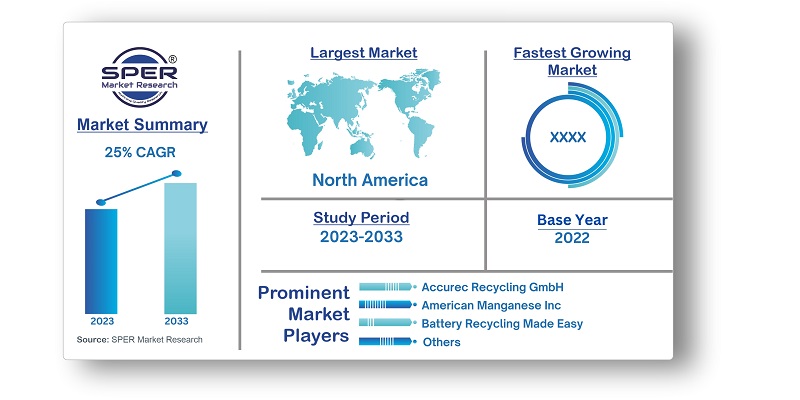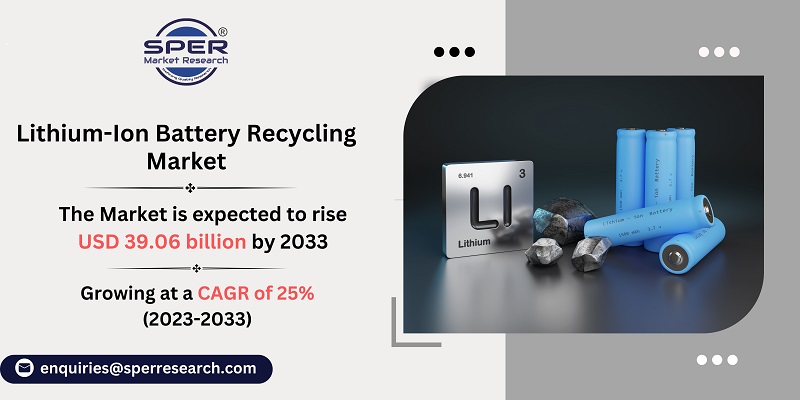
Lithium-Ion Battery Recycling Market Trends, Growth, Size, Share, Revenue and Future Outlook
Lithium-Ion Battery Recycling Market Size- By Battery Chemistry, By Source, By Recycling Process, By End User- Regional Outlook, Competitive Strategies and Segment Forecast to 2033
| Published: Jan-2024 | Report ID: POAE2402 | Pages: 1 - 244 | Formats*: |
| Category : Power & Energy | |||
- Umicore unveiled Battery Recycling Solutions in March 2023 as a new business unit in response to the growing market demand. The objective of this calculated action is to take advantage of the industry's explosive growth and position Umicore as a major participant. Umicore is planning to significantly increase its recycling capacity as part of its growth plans. The business intends to build a cutting-edge, 150,000-ton battery recycling facility in Europe by 2026. With the help of this large-scale initiative, Umicore will be able to meet the growing demands for lithium-ion battery recycling and improve its standing in the industry.
- March 2022: Retriev Technologies has acquired Battery Solutions, forming North America's largest battery management solution. This merger creates a comprehensive recycling offering, establishing a "circular supply chain" for industry and consumers. By integrating their expertise, infrastructure, and services, the company becomes the sole industry player capable of managing all battery types throughout their life cycle. With a strategic national presence, the acquisition reinforces their commitment to the circular economy, addressing the increasing demand for sustainable battery management solutions.


| Report Metric | Details |
| Market size available for years | 2019-2033 |
| Base year considered | 2022 |
| Forecast period | 2023-2033 |
| Segments covered | By Battery Chemistry, By Source, By Recycling Process, By End Use |
| Regions covered | North America, Asia-Pacific, Latin America, Middle East & Africa and Europe |
| Companies Covered | Accurec Recycling GmbH, American Manganese Inc., Battery Recycling Made Easy, Brunp Recycling, Eco-Bat Technologies Ltd., G&P Batteries, GEM Co., Ltd., Glencore International AG, Li-Cycle Corp., LITHION Recycling Inc., Neometals Ltd., Raw Materials Company Inc., Retriev Technologies Inc., Umicore N.V., Others |
- Automotive Industry
- Battery Manufacturers
- Consumers
- Electronics Manufacturers
- Recycling Companies
- Waste Management Companies
- Others
| By Battery Chemistry: | |
| By Source: | |
| By Recycling Process: | |
| By End Use: |
- Global Lithium-Ion Battery Recycling Market Size (FY’2023-FY’2033)
- Overview of Global Lithium-Ion Battery Recycling Market
- Segmentation of Global Lithium-Ion Battery Recycling Market By Battery Chemistry (Lithium-Iron Phosphate, Lithium-Manganese Oxide, Lithium-Nickel-Cobalt-Aluminum Oxide, Lithium-Nickel-Manganese Cobalt, Lithium-Titanate Oxide)
- Segmentation of Global Lithium-Ion Battery Recycling Market By Source (Electric Vehicles, Electronics, Power Tools, Others)
- Segmentation of Global Lithium-Ion Battery Recycling Market By Recycling Process (Hydrometallurgical Process, Physical/Mechanical Process, Pyrometallurgy Process)
- Segmentation of Global Lithium-Ion Battery Recycling Market By End Use (Automotive, Consumer Electronics, Industrial, Non-Automotive)
- Statistical Snap of Global Lithium-Ion Battery Recycling Market
- Expansion Analysis of Global Lithium-Ion Battery Recycling Market
- Problems and Obstacles in Global Lithium-Ion Battery Recycling Market
- Competitive Landscape in the Global Lithium-Ion Battery Recycling Market
- Impact of COVID-19 and Demonetization on Global Lithium-Ion Battery Recycling Market
- Details on Current Investment in Global Lithium-Ion Battery Recycling Market
- Competitive Analysis of Global Lithium-Ion Battery Recycling Market
- Prominent Players in the Global Lithium-Ion Battery Recycling Market
- SWOT Analysis of Global Lithium-Ion Battery Recycling Market
- Global Lithium-Ion Battery Recycling Market Future Outlook and Projections (FY’2023-FY’2033)
- Recommendations from Analyst
1.1. Scope of the report1.2. Market segment analysis
2.1. Research data source2.1.1. Secondary Data2.1.2. Primary Data2.1.3. SPER’s internal database2.1.4. Premium insight from KOL’s2.2. Market size estimation2.2.1. Top-down and Bottom-up approach2.3. Data triangulation
4.1. Driver, Restraint, Opportunity and Challenges analysis4.1.1. Drivers4.1.2. Restraints4.1.3. Opportunities4.1.4. Challenges4.2. COVID-19 Impacts of the Global Lithium-Ion Battery Recycling Market
5.1. SWOT Analysis5.1.1. Strengths5.1.2. Weaknesses5.1.3. Opportunities5.1.4. Threats5.2. PESTEL Analysis5.2.1. Political Landscape5.2.2. Economic Landscape5.2.3. Social Landscape5.2.4. Technological Landscape5.2.5. Environmental Landscape5.2.6. Legal Landscape5.3. PORTER’s Five Forces5.3.1. Bargaining power of suppliers5.3.2. Bargaining power of buyers5.3.3. Threat of Substitute5.3.4. Threat of new entrant5.3.5. Competitive rivalry5.4. Heat Map Analysis
6.1. Global Lithium-Ion Battery Recycling Market Manufacturing Base Distribution, Sales Area, Product Type6.2. Mergers & Acquisitions, Partnerships, Product Launch, and Collaboration in Global Lithium-Ion Battery Recycling Market
7.1. Global Lithium-Ion Battery Recycling Market Value Share and Forecast, By Battery Chemistry, 2023-20337.2. Lithium-Iron Phosphate7.3. Lithium-Manganese Oxide7.4. Lithium-Nickel-Cobalt-Aluminum Oxide7.5. Lithium-Nickel-Manganese Cobalt7.6. Lithium-Titanate Oxide
8.1. Global Lithium-Ion Battery Recycling Market Value Share and Forecast, By Source, 2023-20338.2. Electric Vehicles8.3. Electronics8.4. Power Tools8.5. Others
9.1. Global Lithium-Ion Battery Recycling Market Value Share and Forecast, By Recycling Process, 2023-20339.2. Hydrometallurgical Process9.3. Physical/Mechanical Process9.4. Pyrometallurgy Process
10.1. Global Lithium-Ion Battery Recycling Market Value Share and Forecast, By End Use, 2023-203310.2. Automotive10.3. Consumer Electronics10.4. Industrial10.5. Non-Automotive
11.1. Global Lithium-Ion Battery Recycling Market Size and Market Share
12.1. Global Lithium-Ion Battery Recycling Market Size and Market Share By Battery Chemistry (2019-2026)12.2. Global Lithium-Ion Battery Recycling Market Size and Market Share By Battery Chemistry (2027-2033)
13.1. Global Lithium-Ion Battery Recycling Market Size and Market Share By Source (2019-2026)13.2. Global Lithium-Ion Battery Recycling Market Size and Market Share By Source (2027-2033)
14.1. Global Lithium-Ion Battery Recycling Market Size and Market Share By Recycling Process (2019-2026)14.2. Global Lithium-Ion Battery Recycling Market Size and Market Share By Recycling Process (2027-2033)
15.1. Global Lithium-Ion Battery Recycling Market Size and Market Share By End Use (2019-2026)15.2. Global Lithium-Ion Battery Recycling Market Size and Market Share By End Use (2027-2033)
16.1. Global Lithium-Ion Battery Recycling Market Size and Market Share By Region (2019-2026)16.2. Global Lithium-Ion Battery Recycling Market Size and Market Share By Region (2027-2033)16.3. Asia-Pacific16.3.1. Australia16.3.2. China16.3.3. India16.3.4. Japan16.3.5. South Korea16.3.6. Rest of Asia-Pacific16.4. Europe16.4.1. France16.4.2. Germany16.4.3. Italy16.4.4. Spain16.4.5. United Kingdom16.4.6. Rest of Europe16.5. Middle East and Africa16.5.1. Kingdom of Saudi Arabia16.5.2. United Arab Emirates16.5.3. Rest of Middle East & Africa16.6. North America16.6.1. Canada16.6.2. Mexico16.6.3. United States16.7. Latin America16.7.1. Argentina16.7.2. Brazil16.7.3. Rest of Latin America
17.1. Accurec Recycling GmbH17.1.1. Company details17.1.2. Financial outlook17.1.3. Product summary17.1.4. Recent developments17.2. American Manganese Inc.17.2.1. Company details17.2.2. Financial outlook17.2.3. Product summary17.2.4. Recent developments17.3. Battery Recycling Made Easy17.3.1. Company details17.3.2. Financial outlook17.3.3. Product summary17.3.4. Recent developments17.4. Brunp Recycling17.4.1. Company details17.4.2. Financial outlook17.4.3. Product summary17.4.4. Recent developments17.5. Eco-Bat Technologies Ltd.17.5.1. Company details17.5.2. Financial outlook17.5.3. Product summary17.5.4. Recent developments17.6. G&P Batteries17.6.1. Company details17.6.2. Financial outlook17.6.3. Product summary17.6.4. Recent developments17.7. GEM Co., Ltd.17.7.1. Company details17.7.2. Financial outlook17.7.3. Product summary17.7.4. Recent developments17.8. Glencore International AG17.8.1. Company details17.8.2. Financial outlook17.8.3. Product summary17.8.4. Recent developments17.9. Li-Cycle Corp.17.9.1. Company details17.9.2. Financial outlook17.9.3. Product summary17.9.4. Recent developments17.10. LITHION Recycling Inc.17.10.1. Company details17.10.2. Financial outlook17.10.3. Product summary17.10.4. Recent developments17.11. Neometals Ltd.17.11.1. Company details17.11.2. Financial outlook17.11.3. Product summary17.11.4. Recent developments17.12. Raw Materials Company Inc.17.12.1. Company details17.12.2. Financial outlook17.12.3. Product summary17.12.4. Recent developments17.13. Retriev Technologies Inc.17.13.1. Company details17.13.2. Financial outlook17.13.3. Product summary17.13.4. Recent developments17.14. Umicore N.V.17.14.1. Company details17.14.2. Financial outlook17.14.3. Product summary17.14.4. Recent developments17.15. Others
SPER Market Research’s methodology uses great emphasis on primary research to ensure that the market intelligence insights are up to date, reliable and accurate. Primary interviews are done with players involved in each phase of a supply chain to analyze the market forecasting. The secondary research method is used to help you fully understand how the future markets and the spending patterns look likes.
The report is based on in-depth qualitative and quantitative analysis of the Product Market. The quantitative analysis involves the application of various projection and sampling techniques. The qualitative analysis involves primary interviews, surveys, and vendor briefings. The data gathered as a result of these processes are validated through experts opinion. Our research methodology entails an ideal mixture of primary and secondary initiatives.



Frequently Asked Questions About This Report
PLACE AN ORDER
Year End Discount
Sample Report
Pre-Purchase Inquiry
NEED CUSTOMIZATION?
Request CustomizationCALL OR EMAIL US
100% Secure Payment






Related Reports
Our Global Clients
Our data-driven insights have influenced the strategy of 200+ reputed companies across the globe.




















